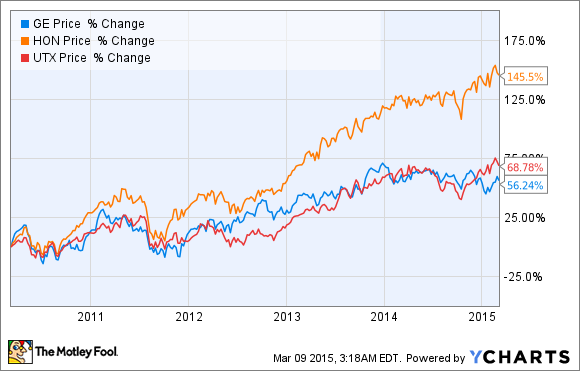Asking yourself whether you prefer to buy a U.S. 10 Year Treasury note yielding 2.1%, or General Electric Company (GE -0.69%) stock with a current dividend yield of 3.5% might appear to be a superfluous task. Obviously buying the stock makes more sense, right? Unfortunately, investing is rarely that simple, so before you spend your money, let's take a quick look at the key factors that will help you make this choice.
 Source: Motley Fool Flickr
Source: Motley Fool Flickr
Why compare bond yields with earnings and dividend yields?
Investors like to compare bond yields with earnings yields, because if bond yields are lower than earnings yields, theoretically at least, an investor could borrow money and get a better return by buying stocks.
As interest rates fall, the yield on a stock should become more attractive as a source of income. In this case, the comparison is with dividend yields, because that's the primary focus of an income investor.
GE Dividend Yield (TTM) data by YCharts
General Electric Company stock: Out of love
It's also fair to say General Electric is currently out of favor with the market. It appears that investors haven't really forgiven CEO Jeff Immelt for cutting the dividend in 2009, or for the disappointing earnings growth during his tenure. Here is a look at its under-performance versus two of its peers in the last five years..
Given this change in sentiment in the market, is now the time to take a contrarian view and buy the stock for the long-term?
Can General Electric grow its dividend?
The current comparison of GE's dividend yield versus bond yields looks favorable for buying the stock. However it's entirely possible that interest rates could rise (taking treasury yields with them) while GE struggles to grow its dividend. It's very difficult to predict long-term interest rate movements, but it's easier to look at the factors determining GE's dividend.
First of all, the payout ratio -- Dividend Per Share, or DPS, divided by Earnings Per Share, or EPS -- has risen in recent years. In addition, the DPS to Free-Cash Flow Per Share, or FCF-PS, ratio has also increased markedly -- an indication that the industrial giant might find it tough to increase dividends in future years.
Incidentally, I prefer to also check the FCF-PS ratio -- it's what dividends are actually paid from.

Source: General Electric Company Presentations
One way to calculate the dividend growth potential is to use the Gordon Growth Model -- a worked example in the linked article. Under the model, the potential for the company to grow its dividend "g" is explained below.
- G=ROE x (1-D/E)
- Where ROE is Return On Equity
- D/E is the payout ratio
The 10-year average ROE is 13.1% and, assuming a payout ratio of 59% gives a theoretical dividend growth rate of 5.3% per annum. Given that last year's total dividend was $0.89, this means that the dividend could be around $1.5 in 10 years time -- equating to a yield of around 5.7%, at today's stock price.
On the right track
Projecting dividend and earnings growth is one thing, and achieving it is another. As General Electric investors know Jeff Immelt's tenure has seen the stock markedly fail to generate the returns generated by Jack Welch.
The reasons why are discussed in the linked article, suffice to mention that Immelt took over a company that wasn't really structured to deal with rising oil prices. Moreover, the aviation market took a hit after the 9/11 attacks, and GE Capital was a major loser in the financial crisis.
Going forward, the company's long-term growth prospects look positive, and the integration of Alstom's energy business creates a growth opportunity from consolidating an industry where General Electric is a world leader. Moreover, power and water is actually the major segment generating the highest return on assets for General Electric -- growing the power business via buying Alstom is an indication that ROE might increase in future.
Time to buy General Electric Company stock over a 10-year note?
All told, if the company continues to generate ROE in-line with the last decade, the stock won't be particularly attractive. My projection of a 5.7% dividend yield in 10 years' time doesn't give much room for error on interest rates. In other words, if bond yields start climbing, then the stock will start to look expensive on a dividend yield basis, and a 5.7% dividend yield isn't much of a 10 year target in any case.
On the other hand, if General Electric can increase its ROE -- and I think it can -- and pull up earnings and dividend growth, then the stock is very attractive for income seekers. On balance, I think General Electric is a better value than buying a 10-Year Treasury right now, but only if it improves productivity.







